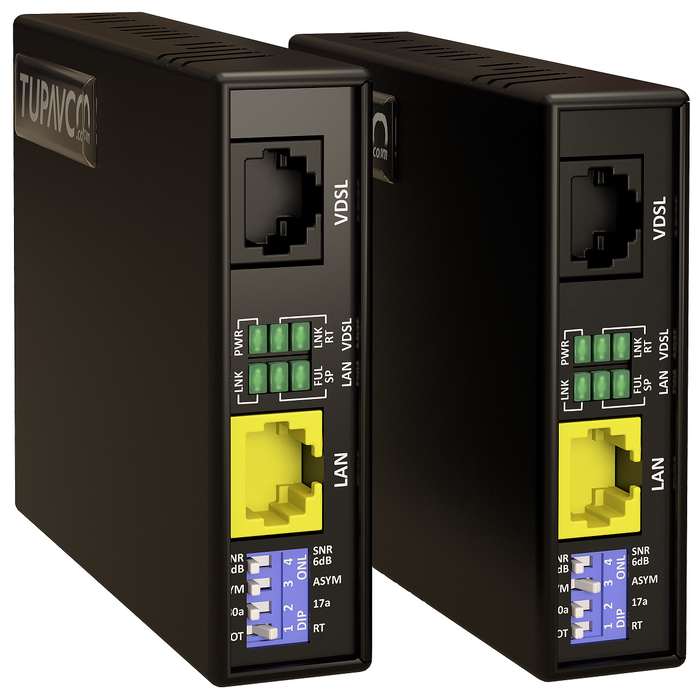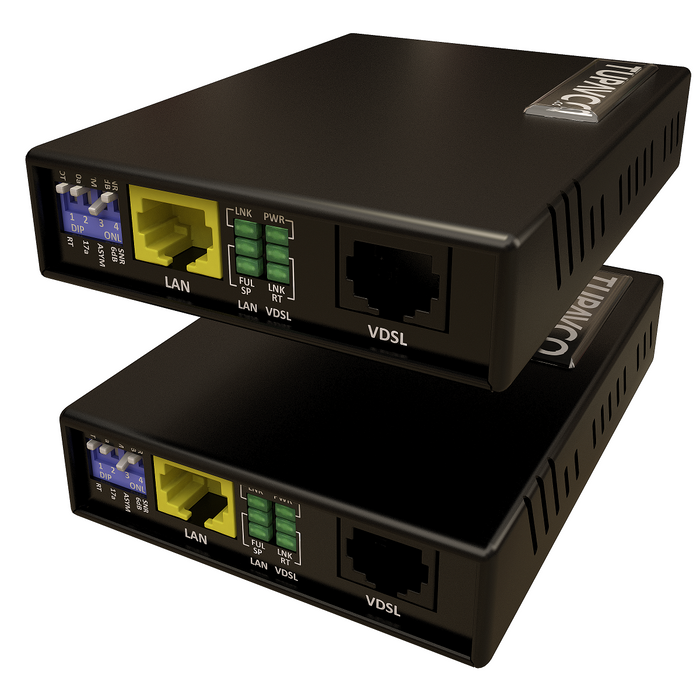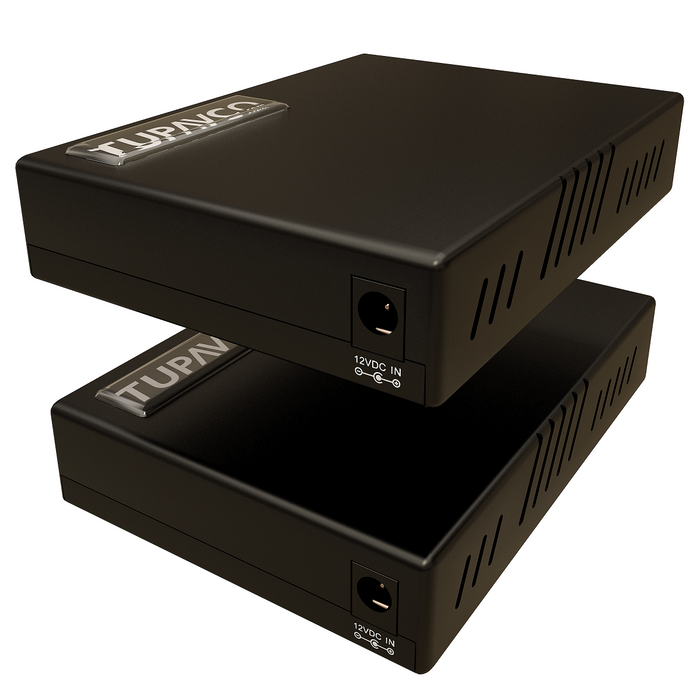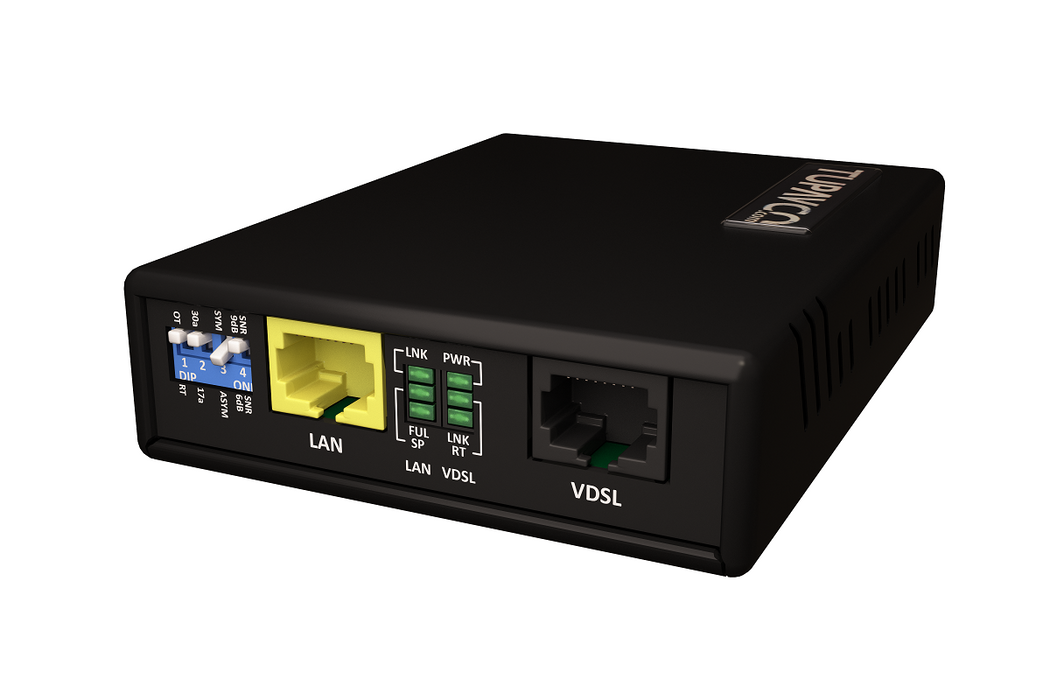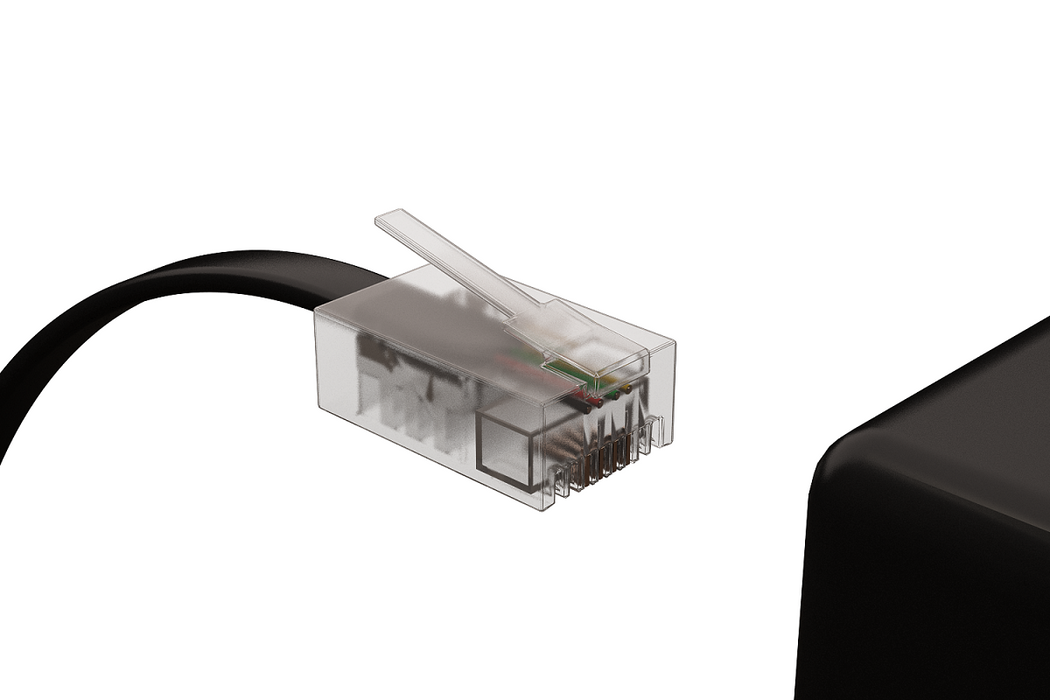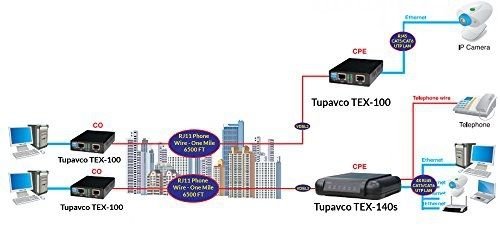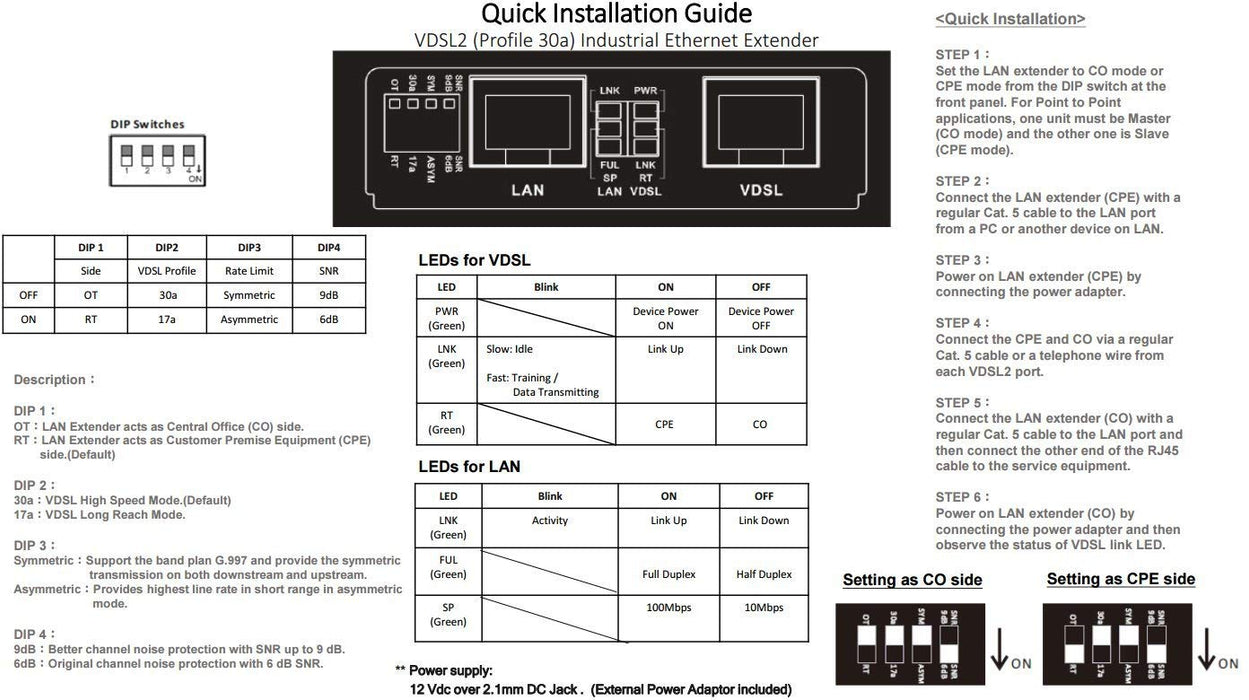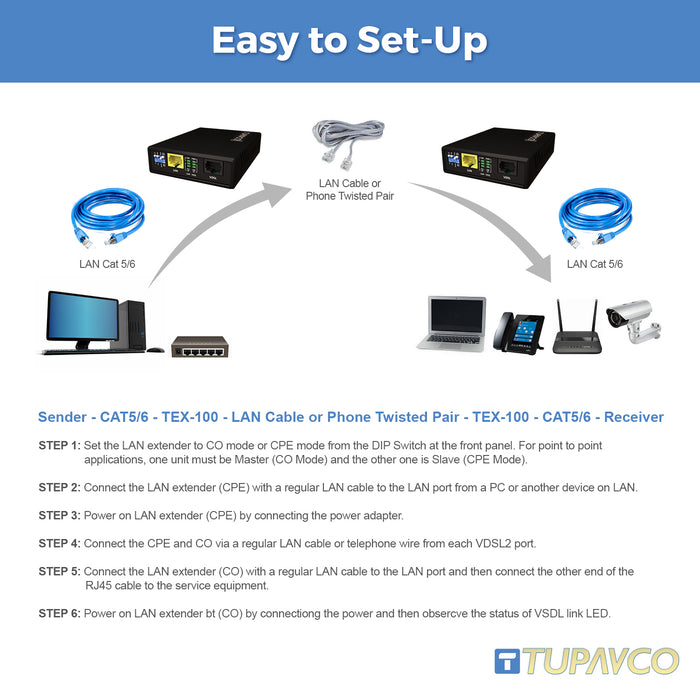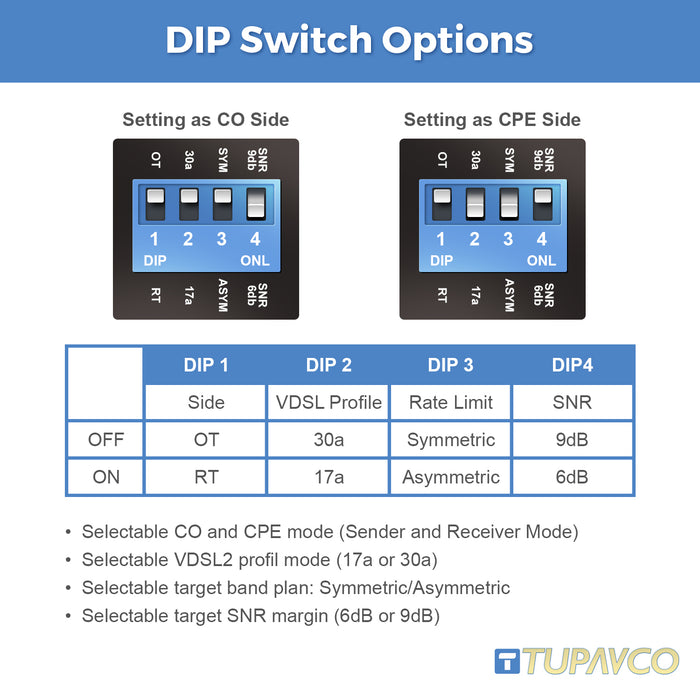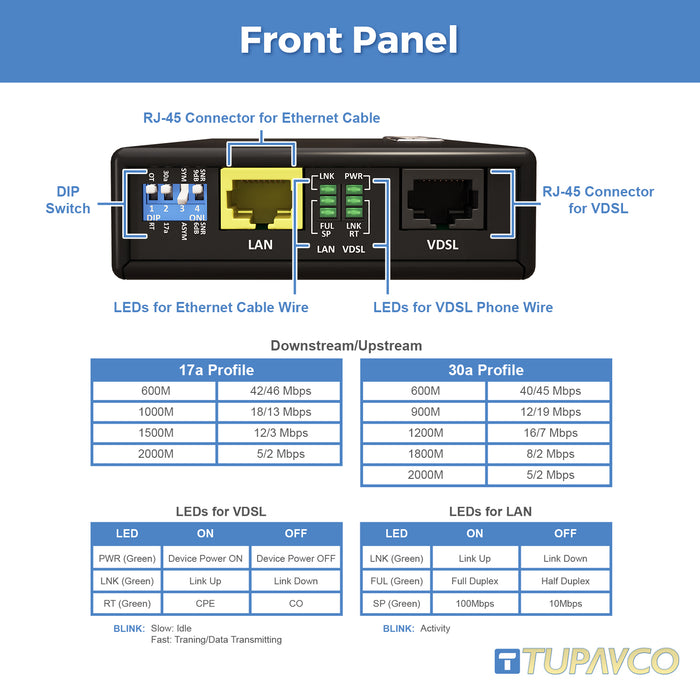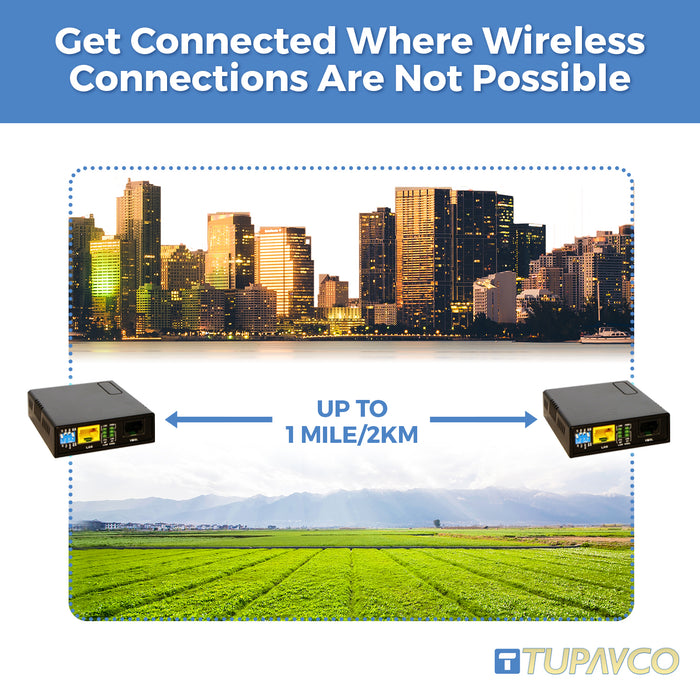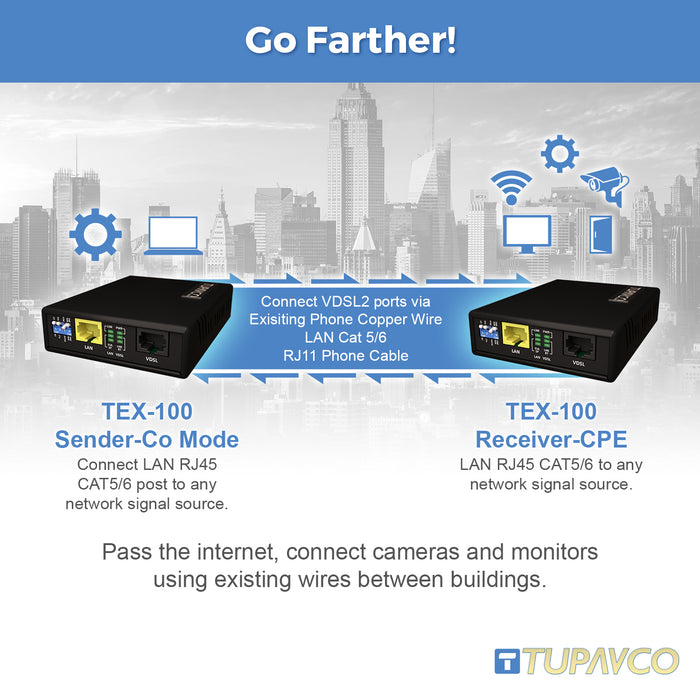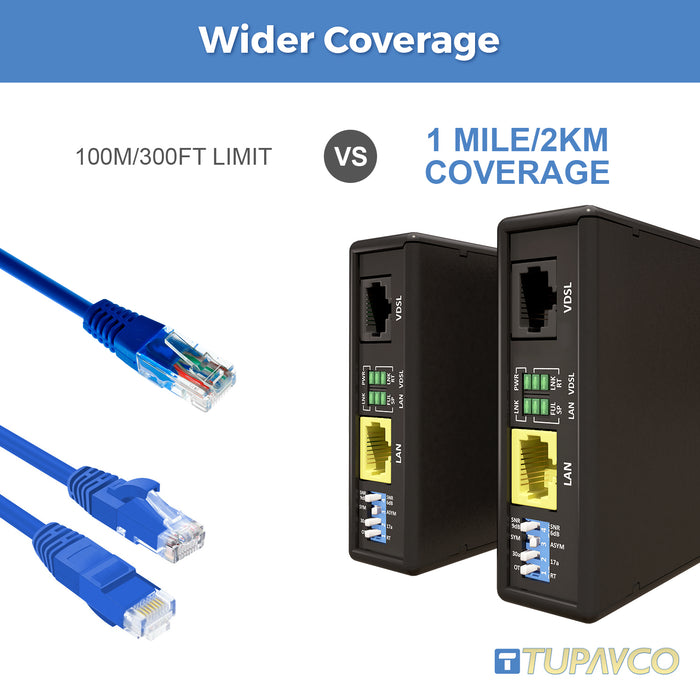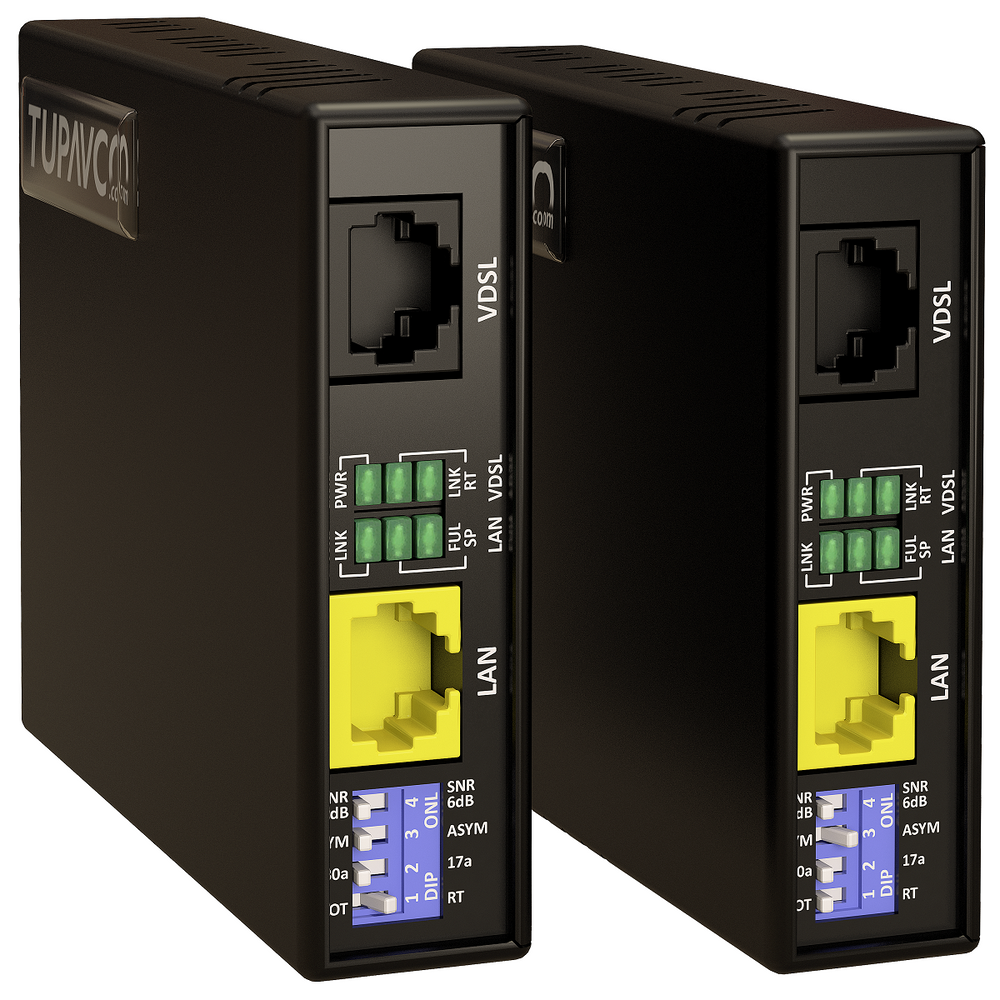Ethernet Extender Kit - 2pc Pair TEX-100 - Range up to 1 Mile over Phone Copper Wire or Network Cable
Ethernet Extender Kit TEX-100
UPC: 741360889125
Model Number: TP1321
Ethernet Extender Kit TEX-100 extends the ethernet cable (CAT5, CAT6, CAT7, RJ45) range well beyond 328 feet (100m) limit to up to 7000 ft (2 km) over 2-wire twisted pair. The ethernet booster uses VDSL2 technology to extend network service through a single-pair phone line copper wire or an existing RJ-45 cable. This network extender kit can use an existing network or phone line setup to deliver long reach ethernet cable signal where the wireless signal transmission is not possible or in situations where a wired signal is limited by the RJ45 cable length.
These simple and effective point to point network boosters are perfect for commercial buildings, residential units, hospitality environments, remote office spaces or private-network backbone to a corporate LAN. Network Extender can be used to connect separate buildings on remote locations where cable connection (RJ-45 or telephone line) is available or already exist, or connect remote devices (i.e. PC, computer, digital sensors in the field, AP, VoIP phone, WiFi APs, IP Camera, Intercom, Modem, Router) to the main ethernet/internet source. It reduces the cost and hassles of new installations by utilizing installed voice-grade twisted pairs to eliminate the expenses of fiber or new cable infrastructure.
The Ethernet Extender TEX-100 kit from Tupavco comes in a pair, a sender and receiver, and is Plug-And-Play ready and easy to set up with no configuration, driver, or software needed. To establish a point-to-point connection, devices are factory preset in CO and CPE (RT) modes as the sender and receiver for the source and remote location side, respectively, through DIP switch settings. A single model can be used in both locations with appropriate DIP switch settings. The instructional manual and a quick installation guide can be downloaded from the listing page.
Four DIP switch user-selectable settings provide the flexibility required to achieve the optimal speed-distance combination and can optimize performance based on the quality of the line, speed, the distance to reach, different applications scenarios, and network topology. Use DIP switches to setup and control CO or CPE mode, 30a or 17a profile, Symmetric or Asymmetric band plan and 6dB or 9dB SNR margin. With DIP switch settings tweaking, broadband speed or distance improvements that best suits your project.

The LAN RJ-45 port is designed to connect to the Local Network with the UTP or STP network cable, while VDSL RJ45 port (Phoenix connector) is designed to connect to another VDSL device. The VDSL port uses only two R1 & T1 RJ11 wires (red and green) and can be plugged in directly. Ethernet Transceivers need to have a copper path to VDSL ports with nothing in between them. If the telephone cable is not free and is occupied with a voice line, a VDSL Splitter should be added on the line ends to use data and voice at the same time over a single pair. It is also possible to run multiple pairs of TEX-100 devices using single CAT 5 / CAT 6 cable by using different twisted pairs in the cable, but some cross interference is possible depending on the cable quality.
Symmetric & Asymmetric Transmission
TEX-100 LAN extender uses second-generation VDSL technology (VDSL2). When operating under profile 30a, the ethernet repeater can provide an aggregate VDSL line rate capability of 100/100 Mbps. 30a profile or High-Speed Mode provides communication protection for up to a 250ms impulse with 660ms~970 ms latency while 17a profile or Long-Reach Mode direct data transmission provides a latency of 1182~1474 ms. Full-duplex data-line rate of 100 Mbps provides near fiber performance for bandwidth-intensive applications. Actual performance may vary depending on the distance and other factors, such as AWG gauge and wire condition.
Ethernet repeater TEX-100 operates in symmetric and asymmetric mode. Symmetrical connections are ideal when using VoIP solutions, like hosted phone system. Being able to achieve consistent upload and download speeds prevents delays and provides optimal audio quality. Asymmetric mode offers a greater bandwidth for downloads by sacrificing bandwidth available for uploads.

High Speed, Long Reach
The SNR margin is the Signal to Noise Ratio margin. Even the most perfect cable absorbs some noise. This "noise" is electromagnetic interference produced by other cables running near the cable, faulty connectors, and other radio systems. Selectable target SNR margin (6dB or 9dB) effectively defines the buffer required in signal-to-noise ratio to protect your broadband connection from the fluctuations that can occur over time in signal and noise levels. Inferior lines tend to require higher target SNR margins to avoid disconnections. On a good line, 6 dB SNR margin is appropriate to maintain a connection without a significant number of drops or errors.
Each TEX-100 unit from the kit can be used as a remote device in DSLAM application and the unit is compatible with 724M/708M DSLAM and a majority of a third-party DSLAMs. DSLAM aggregates the individual subscriber lines over asynchronous transfer mode (ATM), frame relay, or Internet Protocol networks and connects subscribers to their ISP.
Versatile and Effective
Ethernet Extender can be used in standalone applications, or rackmount server chassis applications, where multiple ethernet extenders can be inserted into a rack-mount chassis bay slot (up to 17 units, 2U, 19”) and be powered by a single internal power supply. Cross-flow cooling fan on units is specially designed for this environment. The hot-swap feature allows any extender to be removed and replaced while the completely uninterrupted system remains running.
Ethernet Extenders does not support PoE (power transfer) through VDSL to the remote location. Please make sure that the product fits your application. If there is a problem to pass the signal through a long cable, set up Ethernet extenders next to each other with a short test cable to start communication, so they can be tested before deploying. If you have any questions before you order or if you are not able to set the kit up, let us know and we will help you to make the kit work.
Two sets of three LED indicators are built-in for easy diagnosing and monitoring the status of power, CO/CPE mode, idle/trained/link, link activity, data rate 10/100Mbps and Half/Full Duplex mode.
A half-duplex (HDX) provides communication in both directions, but only one direction at a time. A full-duplex (FDX) system, or sometimes called double-duplex, allows communication in both directions simultaneously. An example of a half-duplex system is a two-party system such as a walkie-talkie while an example of a full-duplex system is telephone line, as it allows both callers to speak and be heard at the same time. Ethernet Extender supports and detects both half and full duplex mode.
Investing in a compact, easy to install ethernet bridge repeater with all of the needed features and proven reliability can be the most cost-effective solution to enable data transmission to remotely located ethernet devices.
Manual (PDF)
Quick Installation Guide (PDF)
Das Ethernet Extender Kit TEX-100 erweitert die Reichweite des Ethernet-Kabels (CAT5, CAT6, CAT7, RJ45) weit über 100 m hinaus auf bis zu 2 km über 2-Draht-Twisted-Pair. Der Ethernet-Booster nutzt die VDSL2-Technologie, um den Netzwerkservice über eine Kupferleitung mit einer einzigen Telefonleitung oder einem vorhandenen RJ-45-Kabel zu erweitern. Dieses Netzwerkverlängerungs-Kit kann ein bestehendes Netzwerk oder eine bestehende Telefonleitung verwenden, um ein weitreichendes Ethernet-Kabelsignal zu liefern, wenn die drahtlose Signalübertragung nicht möglich ist oder wenn ein kabelgebundenes Signal durch die RJ45-Kabellänge begrenzt ist.
Diese einfachen und effektiven Punkt-zu-Punkt-Netzwerk-Booster sind perfekt für Geschäftsgebäude, Wohneinheiten, Gastgewerbeumgebungen, entfernte Büroräume, Privatnetzwerk oder Backbone als Firmen-LAN. Der Netzwerk-Extender kann verwendet werden, um separate Gebäude mit entfernten Orten zu verbinden, an denen eine Kabelverbindung (RJ-45 oder Telefonleitung) vorhanden ist, bereits existiert oder um entfernte Geräte (d.h. PC, Computer, digitale Sensoren im Feld, AP, VoIP-Telefon, WiFi-APs, IP-Kamera, Gegensprechanlage, Modem, Router) zur Hauptquelle Ethernet/Internet zu verbinden. Die Kosten und Probleme werden bei Neuinstallationen durch die Verwendung der installierten Sprachqualität Twisted Pairs reduziert. Außerdem werden die Kosten für Glasfaser oder neue Kabelinstallationen vermieden.
Der Ethernet Extender TEX-100 Kit wird paarweise als Sender und Empfänger geliefert. Der Extender ist Plug-and-Play-fähig und einfach einzurichten, ohne Konfiguration, Treiber oder Software. Um eine Punkt-zu-Punkt-Verbindung herzustellen, werden die Geräte werkseitig in den CO und CPE (RT) Modi als Sender und Empfänger für die Quell- bzw. Remote-Standorte über DIP-Schalter eingestellt. Ein einziges Modell kann an beiden Standorten mit entsprechenden DIP-Schaltereinstellungen verwendet werden. Die Bedienungsanleitung und eine Kurzanleitung zur Installation können von der Webseite heruntergeladen werden.
Die vier DIP-Schalter, die vom Benutzer einstellbar sind, bieten die nötige Flexibilität, um die optimale Performance der Geschwindigkeits-Distanz-Kombination zu erreichen und können die Leistung basierend auf die Qualität der Strecke, der Geschwindigkeit, der zu erreichenden Entfernung, verschiedenen Anwendungsszenarien und der Netzwerktopologie optimieren. Verwenden Sie DIP-Schalter, um den CO- oder CPE-Modus, 30a- oder 17a-Profile, symmetrische oder asymmetrische Bandpläne und 6dB- oder 9dB-SNR-Ränder einzustellen und zu steuern. Mit den DIP-Schalter-Einstellungen können die Breitbandgeschwindigkeit oder Entfernungsverbesserung auf Ihr Projekt optimiert werden.
Der TEX-100 LAN Extender verwendet die VDSL-Technologie der zweiten Generation (VDSL2). Bei Betrieb unter Profil 30a kann der Ethernet-Repeater einen Leitungswert von 100/100 Mbit/s bereitstellen. Das 30a-Profil oder der High-Speed-Modus bietet einen Kommunikationsschutz für bis zu einen 250ms-Impuls mit 660ms~970 ms Latenzzeit, während ein 17a-Profil oder der Long-Reach-Modus die direkte Datenübertragung eine Latenz von 1182~1474 ms bietet. Die Vollduplex-Datenleitungsrate von 100 Mbit/s bietet eine fasernahe Leistung für intensive Bandbreite Anwendungen. Die tatsächliche Leistung variiert je nach Entfernung und Faktoren, wie z.B. AWG-Messgerät und Zustand des verwendeten Kabels.
Der Ethernet-Repeater TEX-100 arbeitet im symmetrischen und asymmetrischen Modus. Die symmetrischen Verbindungen sind ideal für die Nutzung von VoIP-Anwendungen, wie z.B. gehostete Telefonanlagen. Die Möglichkeit, konsistente Upload- und Download-Geschwindigkeiten zu erreichen, verhindert Verzögerungen und sorgt für eine optimale Audioqualität. Der asymmetrische Modus bietet eine größere Bandbreite für Downloads, indem er die verfügbare Bandbreite für Uploads reduziert.
Der SNR-Margin ist das Signal-Rausch-Verhältnis. Selbst das perfekteste Kabel absorbiert Geräusche. Dieses "Rauschen" ist eine elektromagnetische Störung, die durch andere Kabel, die in der Nähe des Kabels gelegt sind, fehlerhafte Stecker und andere Funksysteme, verursacht werden. Der wählbare SNR (6dB oder 9dB) definiert den Puffer effektiv, der im Signal-Rausch-Verhältnis benötigt wird, um Ihre Breitbandverbindung vor den Schwankungen zu schützen, die im Laufe der Zeit bei Signal- und Rauschpegeln auftreten können. Niedrigere Leitungen erfordern tendenziell höhere SNR-Margins, um Trennungen zu vermeiden. Auf einer guten Leitung ist eine 6 dB SNR-Margin angemessen, um eine Verbindung ohne eine signifikante Anzahl von Störungen oder Fehlern aufrechtzuerhalten.
Jede TEX-100-Einheit aus dem Kit kann als Remote-Gerät in einer DSLAM-Anwendung verwendet werden. Die Einheit ist mit 724M/708M DSLAM und einer Mehrheit von DSLAMs von Drittanbietern kompatibel. DSLAM aggregiert die einzelnen Teilnehmeranschlüsse über asynchrone Übertragungsmodi (ATM), Frame Relay oder Internet Protocol-Netzwerke, verbindet die Teilnehmer mit ihrem Internet Service Provider (ISP) oder aggregiert einzelne Teilnehmeranschlüsse zu einer Hochleistungsverbindung.
Ethernet Extender können in eigenständigen Anwendungen oder in Rackmount-Server-Chassis Anwendungen verwendet werden, bei denen mehrere Ethernet-Extender in einen Rack-Mount Chassis eingesetzt werden können (bis zu 17 Einheiten, 2U, 48 cm) und von einem einzigen internen Netzteil versorgt werden. Der Querstrom-Kühlventilator der Geräte ist speziell für diese Umgebung ausgelegt. Die Hot-Swap-Funktion ermöglicht es, jeden Extender zu entfernen und zu ersetzen, während das System ununterbrochen weiterläuft.
Der LAN RJ-45-Anschluss ist für die Verbindung mit dem lokalen Netzwerk über das UTP- oder STP-Netzwerkkabel ausgelegt, während der VDSL RJ45-Anschluss (Phoenix-Anschluss) für die Verbindung mit einem anderen VDSL-Gerät ausgelegt ist. Der VDSL-Anschluss verwendet nur zwei R1 & T1 RJ11-Kabel (rot und grün) und kann direkt eingesteckt werden. Die Ethernet Senderempfänger müssen einen Kupferpfad zu VDSL-Ports haben, zwischen denen sich nichts befinden darf. Wenn das Telefonkabel nicht frei ist und mit einer Sprachleitung belegt ist, sollte an den Leitungsenden ein VDSL-Splitter hinzugefügt werden, um Daten und Sprache gleichzeitig über ein einziges Paar nutzen zu können. Es ist auch möglich, mehrere Paare von TEX-100-Geräten mit einem einzigen CAT 5 / CAT 6-Kabel zu verwenden, indem verschiedene verdrillte Paare im Kabel verwendet werden, je nach Kabelqualität sind einige Querstörungen jedoch möglich.
Es sind zwei Sets von drei LED-Indikatoren eingebaut, um den Leistungsstatus, den CO/CPE-Modus, den Leerlauf/Training/Link, die Verbindungsaktivität, die Datenrate 10/100Mbps und den Halb-/Vollduplex-Modus einfach zu diagnostizieren und zu überwachen...
Ein Halbduplex (HDX) ermöglicht die Kommunikation in beide Richtungen, aber immer nur in eine Richtung gleichzeitig. Ein Vollduplex System (FDX) oder manchmal auch Doppelduplex genannt, ermöglicht die gleichzeitige Kommunikation in beide Richtungen. Ein Beispiel für ein Halbduplexsystem ist ein Zweiparteiensystem wie ein Walkie-Talkie, während ein Beispiel für ein Vollduplexsystem eine Telefonleitung ist, dadurch können beide Anrufer gleichzeitig sprechen und gehört werden. Der Ethernet Extender unterstützt und erkennt sowohl den Halb- als auch den Vollduplexmodus.
Die Ethernet Extender unterstützen keine PoE (Stromübertragung) über VDSL zum entfernten Standort. Bitte stellen Sie sicher, dass das Produkt zu Ihrer Anwendung passt. Wenn es ein Problem gibt, das Signal durch ein langes Kabel zu leiten, stellen Sie die Ethernet-Extender mit einem kurzen Testkabel nebeneinander auf, um die Kommunikation zu starten, damit sie vor dem Einsatz getestet werden können. Wenn Sie Fragen haben, bevor Sie bestellen oder wenn Sie das Kit nicht einrichten können, lassen Sie es uns wissen und wir werden Ihnen helfen, das Kit einzurichten.
Die Investition in einen kompakten, einfach zu installierenden Ethernet-Bridge-Repeater mit allen erforderlichen Funktionen und gewährte Zuverlässigkeit kann die kostengünstigste Lösung für die Datenübertragung zu entfernten Ethernet-Geräten sein.
Le kit d’extension Ethernet TEX-100 rallonge la portée du câble Ethernet (CAT5, CAT6, CAT7, RJ45) bien au delà des 100 m jusqu’à plus de 2 km sur deux fils à paires torsadées. L’amplificateur Ethernet utilise la tech-nologie VDSL2 pour rallonger les services réseaux sur une seule paire de câbles téléphoniques en cuivre ou sur un câble existant RJ45. Notre kit d’extension de réseau peut utiliser une installation réseau ou une ligne télé-phonique existante pour émettre un signal Ethernet à longue portée quand le signal de transmission sans fil est impossible ou quand le signal de transmission filaire est limité par la longueur d’un câble RJ45.
Nos amplificateurs de réseau point à point constituent une solution parfaite pour des immeubles commer-ciaux, pour des unités résidentielles, des environnements hospitaliers, des espaces à bureaux distants, ou comme épine dorsale reliant un réseau privé à un réseau d’entreprise. Le prolongateur réseau peut être utilisé pour connecter des bâtiments séparés sur des emplacements distants où la connexion filaire (RJ45 ou ligne téléphonique) est disponible ou déjà existante, ou pour connecter des appareils distants (à savoir un PC, un ordinateur, des capteurs numériques sur le terrain, un AP, un téléphone VoIP, des AP Wifi, une caméra IP, un interphone, un modem ou un routeur) à la source de données Ethernet ou Internet principale. Notre dispositif réduit le coût et les tracas de la nouvelle mise en place en utilisant les paires torsadées de qualité vocale in-tégrées pour supprimer les frais de fibre optique ou d’une nouvelle infrastructure filaire.
Le kit de prolongateur Ethernet TEX-100 comprend la paire, émetteur et receveur et il est prêt à l’emploi et facile à mettre en place ne nécessitant aucune configuration, pilote ou logiciel. Pour établir une connexion point à point, le dispositif est préréglé à l’usine en modes CO et CPE (RT) correspondant à l’émetteur et au receveur respectivement pour la partie source et la partie à distance, grâce aux réglages du commutateur DIP. Un modèle unique peut être utilisé aux deux emplacements avec des réglages appropriés du commutateur DIP. Un manuel d’instruction et un guide d’installation rapide peuvent être téléchargés depuis la page de la fiche.
Quatre commutateurs DIP paramétrés par l’utilisateur offrent la flexibilité nécessaire pour atteindre la com-binaison vitesse-distance optimale et peuvent optimiser la performance basée sur la qualité de la ligne, la vitesse, la distance à atteindre, les différents scénarios d’applications et la topologie du réseau. Utilisez les commutateurs DIP pour mettre en place et contrôler les modes CO ou CPE, le profil 30a ou 17a, le plan de bande symétrique ou asymétrique et la marge SNR de 6db ou de 9dB. Avec les possibilités de réglage de vo-tre commutateur DIP, paramétrez la vitesse de la bande large ou les améliorations de distance qui con-viennent au mieux à votre projet.
Le prolongateur du réseau local TEX-100 utilise la technologie VDSL de seconde génération (VDSL2). Lors de l’utilisation du profil 30a, le répétiteur Ethernet fournit une capacité à débit en ligne VDSL agrégé de 100/100 Mbps. Le profil 30a ou le mode haut débit offre une protection de la communication jusqu’à une impulsion de 250ms avec un temps de latence de 660 ~ 970 ms, tandis que le profil 17a ou le mode à longue portée de transmission directe de données offre un temps de latence de 1182~1474 ms.Le duplex intégral du débit de la ligne de 100 Mbps fournit un rendement proche de la fibre optique pour des applications qui exigent beaucoup de bande passante. Le rendement réel varie en fonction de la distance et d’autres facteurs, tels que la gauge AWG et l’état du fil utilisé.
Le répétiteur Ethernet TEX-100 fonctionne en mode symétrique et asymétrique. Les connexions symétriques sont idéales lors de l’utilisation des solutions VoIP, comme le système téléphonique hébergé. La possibilité d’atteindre des vitesses de téléchargement et de chargement constantes réduit les retards et assure une quali-té audio optimale. Le mode asymétrique procure une plus grande largeur de la bande pour les télécharge-ments en sacrifiant la largeur de la bande pour les chargements.
La marge SNR est la marge du rapport signal-bruit. Même le meilleur fil absorbe un peu de bruit. Ce “bruit” est du à l’interférence électromagnétique produite par d’autres fils installés à proximité du câble, à de mauvaises connexions ou à d’autres systèmes radio. La marge cible SNR sélectionnable (de 6dB ou de 9 dB) définit effectivement le tampon du rapport signal-bruit nécessaire pour protéger votre connexion haut-débit des fluctuations qui peuvent surgir dans le temps dans les niveaux du signal-bruit. Pour éviter les déconnexions, les lignes inférieures nécessitent souvent des marges cibles SNR plus élevées. Sur une bonne ligne, la marge SNR de 6 dB est appropriée pour assurer le maintien de la connexion sans un nombre important d’erreur ou de chutes.
Chaque unité TEX-100 de notre kit peut être utilisée comme un périphérique à distance d’une application DSLAM, compatible avec DSLAM 724M/708M et la plupart des opérateurs tiers de DSLAM. Le DSLAM agrège des raccordements de chaque abonné sur le mode de transfert asynchrone (ATM), sur un relais de trames ou des réseaux de protocole Internet, et connecte les abonnés à leur fournisseur d’accès Internet (FAI) ou agrège des lignes d’abonnés individuels en un raccordement Internet de haute capacité.
Le prolongateur Ethernet peut être utilisé comme une application autonome, ou comme une application châssis monté sur bâti, quand des rallonges Ethernet multiples peuvent être intégrées dans l’emplacement d’une baie de châssis montée sur bâti (jusqu’à 17 unités, 2U, 19”) et alimentées par une seule alimentation interne. Les unités sont équipées d’un ventilateur à courant transversal spécialement conçu pour cet environnement. La permutation à chaud permet de retirer et de remplacer toute rallonge sans aucune interruption de fonctionnement du système.
Le port RJ45 du réseau LAN est conçu pour assurer la connexion au réseau local avec des câbles UTP ou STP, et le port VDSL RJ45 (connecteur Phoenix) pour le raccordement à un autre dispositif VDSL. Le port VDSL utilise seulement deux fils R1 et T1 RJ11 (rouge et vert) et se branche directement. Les émetteurs-récepteurs Ethernet nécessitent une piste de cuivre jusqu’aux ports VDSL, sans rien entre eux. Si le câble téléphonique est occupé par une ligne téléphonique, un séparateur VDSL devra être rajouté sur des extrémités de la ligne pour permettre l’utilisation simultanée des services vocaux et des services de données sur une seule paire. Il est également possible d’utiliser plusieurs paires d’unités TEX-100 avec un seul câble CAT5/CAT6 au moyen de différentes paires torsadées dans le câble, sachant que les interférences mutuelles peuvent apparaitre, en fonction de la qualité du câble.
Deux sets de trois témoins DEL intégrés permettant de diagnostiquer et de surveiller facilement l’état d’alimentation, le mode CO ou CPE, le lien inactif ou optimisé, l’activité de la liaison, le débit de données de 10/100 Mbps et le mode semi-duplex ou duplex intégral.
Un semi-duplex (HDX) assure la communication dans les deux directions, mais seulement dans une direction à la fois. Un système duplex intégral (FDX), parfois appelé double duplex, assure une communication bidirec-tionnelle simultanée. Un exemple du système semi-duplex est un système à deux parties tels qu’un talkie-walkie et un exemple du système duplex intégral est une ligne téléphonique, dans la mesure où il permet aux deux appelants de parler et d’être entendus en même temps. Le prolongateur Ethernet soutient et détecte aussi bien le mode semi-duplex que le mode intégral.
Le prolongateur Ethernet ne soutient pas le PoE (le transfert de puissance) au moyen du VDSL vers un em-placement distant. Assurez vous que notre produit correspond à votre application. Si vous rencontrez des problèmes pour passer le signal à travers un long câble, installez les rallonges Ethernet côte à côte, avec un câble test court pour commencer la communication, permettant de les tester avant de les déployer. Si vous avez des questions à nous poser avant de passer votre commande ou si vous rencontrez des difficultés pour mettre en place notre kit, contactez nous et nous vous aiderons à faire fonctionner votre kit.
Investir dans un répétiteur-passerelle Ethernet compact et facile à installer, possédant toutes les caractéristiques requises et d’une fiabilité prouvée, pourrait être la solution la plus économique, pour vous permettre d’assurer la transmission de données vers un périphérique Ethernet distant.
Il Kit Amplificatore segnale Ethernet TEX-100 amplifica il raggio del cavo ethernet oltre il limite di 100 m fino a 2 km su un doppino ritorto a 2 cavi. Questo estensore del segnale ethernet utilizza la tecnologia VDSL2 per ampliare il servizio di rete attraverso una cavo telefonico in rame singolo o un cavo RJ-45 pre-esistente. Questo kit può essere utilizzato su una rete esistente o su una configurazione di linea telefonica per poter emettere un segnale del cavo ethernet a lunga portata laddove la trasmissione del segnale wireless non fosse possibile, oppure in situazioni in cui il segnale è limitato dalla lunghezza del cavo RJ45.
Questi semplici ed efficaci amplificatori di rete point-to-point sono perfetti per gli edifici commerciali, per le unità residenziali, per strutture turistiche, per gli spazi di lavoro molto ampi, o come dorsale di rete privata su una LAN aziendale. Questo estensore di rete può essere utilizzato per connettere edifici separati, dove la connessione via cavo (RJ-45 o linea telefonica) è disponibile o già esistente, o per connettere dispositivi remoti (PC, computer, sensori digitali, AP, telefoni VoIP, AP WiFi, Telecamere IP, Intercom, Modem, Router) alla risorsa ethernet/internet principale. Riduce i costi e semplifica le nuove installazioni utilizzando doppini ritorti VG installati, in modo da eliminare i costi della fibra o di un nuova infrastruttura via cavo.
Il Kit Extender Ethernet TEX-100 è composto da una coppia, un ricevitore e un trasmettitore, ed è un dispositivo Plug-and-Play pronto all’uso e facile da installare, senza bisogno di configurazione, driver o software speciali. Per stabilire una connessione point-to-point, i dispositivi hanno una pre-configurazione di fabbrica in modalità CO e CPE (RT) come trasmettitore e ricevitore rispettivamente per la fonte e per il lato della localizzazione remota, attraverso le impostazioni del DIP Switch. Un unico modello può essere utilizzato in entrambe le localizzazioni attraverso l’appropriata configurazione del DIP Switch. Un manuale di istruzioni e una guida rapida all’installazione possono essere scaricate dalla pagina del prodotto.
Quattro impostazioni del DIP Switch selezionabili dall’utente forniscono la flessibilità richiesta per raggiungere la combinazione velocità-distanza ideale, e possono ottimizzare le performance in base alla qualità della linea, alla velocità, alla distanza da raggiungere, ai differenti scenari di applicazione e alla topologia di rete. Utilizza i DIP Switch per impostare e controllare la modalità CO e CPE, il profilo 30a o 17a, la larghezza di banda simmetrica o asimmetrica e il margine di rumore SNR 6dB o 9dB. Regolando le impostazioni del DIP Switch si possono migliorare la velocità e la distanza della banda larga adattandole al tuo specifico progetto.
L’estensore LAN TEX-100 utilizza una tecnologia VDSL di seconda generazione (VDSL2). Quando in funzione sotto il profilo 30a, il ripetitore ethernet può fornire una capacità aggregata di linea VDSL di 100/100 Mbps. Il profilo 30a o High Speed Mode fornisce una protezione di comunicazione fino a 250ms di impulso con latenza di 660ms~970 ms, mentre il profilo 17a o trasmissione diretta di dati in Long-Reach Mode fornisce una latenza di 1182~1474 ms. La velocità di linea modalità full-duplex a 100 Mbps fornisce performance simili alla fibra per le applicazioni a larghezza di banda intensiva. La performance effettiva potrebbe variare in base alla distanza e ad altri fattori, come l’AWG e le condizioni del filo utilizzato.
Il ripetitore ethernet TEX-100 opera in modalità simmetrica e asimmetrica. Le connessioni simmetriche sono ideali quando vengono utilizzate soluzioni VoIP, come i sistemi PBX. Essendo in grado di raggiungere velocità notevoli in download e upload, evitano ritardi e forniscono una qualità audio ottimale. La modalità asimmetrica offre una larghezza di banda maggiore per i download, sacrificando la larghezza di banda disponibile per l’upload.
Il margine SRN è il margine di rapporto segnale/rumore (Signal to Noise Ratio). Anche il più perfetto dei cavi assorbe del rumore. Questo “rumore” è l’interferenza elettromagnetica prodotta dagli altri cavi che circolano vicino al cavo, dai connettori difettosi o da altri sistemi radio. Il margine SNR selezionabile (6dB or 9dB) definisce efficacemente il buffer richiesto nel rapporto segnale/rumore per proteggere la connessione a banda larga dalle fluttuazioni che possono verificarsi nel tempo nei livelli di segnale e rumore. Le linee inferiori tendono a richiedere margini SNR più alti per evitare disconnessioni. Su una buona linea, un margine SNR di 6 dB è sufficiente per mantenere una connessione senza un numero significativo di cadute ed errori.
Ogni unità TEX-100 del kit può essere utilizzata come un dispositivo remoto nell’applicazione DSLAM, e l’unità è compatibile con le DSLAM 724M/708M e la maggior parte delle DSLAM di terze parti. La DSLAM aggrega le linee dei singoli abbonati tramite asynchronous transfer mode (ATM), Frama relay o o reti IP, e connette gli abbonati al loro fornitore di servizi internet (ISP), o unisce le linee degli abbonati individuali in un collegamento ad alta capacità.
L’ethernet extender può essere utilizzato in applicazioni stand-alone o in applicazioni di montaggio in rack, dove multipli ethernet extender possono essere inseriti in uno scaffale rack (fino a 17 unità, 2U, 19’’), ed essere alimentati tramite una singola fonte di alimentazione interna. La ventola di raffreddamento con ventilatore tangenziale sulle unità è specificamente disegnata per questo contesto. La funzione hot-swap consente di rimuovere e sostituire ogni extender permettendo all’intero sistema di rimanere in funzione senza interruzioni.
La porta LAN RJ-45 è progettata per poter connettersi alla rete locale con il cavo di rete UTP o STP, mentre la porta RJ45 VDSL (connettore Phoenix) è progettata per essere connessa ad un altro dispositivo VDSL. La porta VDSL utilizza solo i due cavi R1 e T1 Rj11 (rosso e verde), e può essere direttamente collegata. I ricetrasmettitori Ethernet devono avere dei percorsi in rame verso le porte VDSL senza alcun elemento intermedio. Se il cavo del telefono non è libero ma occupato da una linea vocale, uno splitter VDSL deve essere aggiunto all’estremità della linea per poter utilizzare voce e dati contemporaneamente su una stessa coppia. È possibile inoltre utilizzare diverse coppie di dispositivi TEX-100 che utilizzano un cavo CAT5 / CAT6, utilizzando diversi doppini ritorti nel cavo, ma potrebbero verificarsi delle interferenze incrociate a seconda della qualità del cavo.
Due set di tre indicatori LED sono incorporati per una facile diagnosi e per il monitoraggio dello stato dell’alimentazione, della modalità CO/CPE, inattivo/attivo/connesso, attività della connessione, velocità dati 10/100Mbps e modalità Half/Full Duplex.
Una connessione half-duplex (HDX) permette la comunicazione in entrambe le direzioni, ma solo una direzione alla volta. Il sistema full-duplex (FDX), chiamato anche double-duplex, permette la comunicazione in entrambe le direzioni contemporaneamente. Un esempio di sistema half-duplex è un sistema binario come un walkie-talkie, mentre un esempio di full-duplex è una linea telefonica, che permette ad entrambi gli utenti di ascoltare e parlare allo stesso tempo. L’estensore Ethernet supporta e rileva entrambe le modalità.
L’ethernet extender non supporta trasferimenti Power Over Ethernet tramite VDSL alla posizione remota. Assicurati che questo prodotto sia adatto alle tue esigenze. Se incontri problemi per passare il segnale attraverso un cavo lungo, imposta gli ethernet extender l’uno accanto all’altro con un cavo di prova corto per iniziare la comunicazione, in modo da poterli testare prima dell’implementazione. Se hai qualsiasi tipo di domanda prima di effettuare l’ordine, o se non sei in grado di configurare il kit, contattaci, e ti aiuteremo mettere in funzione il dispositivo.
Investire in un ripetitore ethernet compatto e facile da installare, dotato di tutte le caratteristiche e le funzionalità necessarie, e di provata efficacia, può essere la soluzione più giusta per permettere la trasmissione di dati a dispositivi ethernet localizzati in remoto.
El Kit Extensor de Ethernet TEX-100 amplía el rango del cable de Ethernet (CAT5, CAT6, CAT7, RJ45) más allá del límite de 100 m hasta 2 km por 1 cable de par trenzado de 2 pares. El amplificador Ethernet usa la tecnología VDSL2 para ampliar el servicio de red a través de un cable telefónico de 1 par con alambre de cobre o un cable RJ-45 existente. Este kit amplificador de red puede usar una red existente o una configuración de línea telefónica para emitir una señal de cable Ethernet de largo alcance donde la transmisión de señal inalámbrica no es posible o en situaciones donde una señal por cable está limitada por la longitud del cable RJ45.
Estos amplificadores de red punto a punto simples y efectivos son perfectos para conectar edificios comerciales, residenciales, comercios y hostelería, espacios de oficinas aislados o redes privadas básicas a una red LAN corporativa. El Extensor de Red se puede usar para conectar edificios separados en ubicaciones remotas donde la conexión por cable (RJ-45 o línea telefónica) está disponible o ya existe, o para conectar dispositivos remotos (es decir, PC, ordenador, sensores digitales, AP, teléfono VoIP, APs WiFi, cámara IP, intercomunicador, módem, router) a la fuente principal de Ethernet/Internet. Reduce el coste y las molestias de las nuevas instalaciones al utilizar pares trenzados de grado de voz instalados para eliminar los gastos de una nueva infraestructura de cable o fibra.
El kit Extensor de Ethernet TEX-100 está compuesto por un par, un emisor y un receptor, y está listo para usar automáticamente, es un dispositivo Plug-And-Play fácil de instalar sin necesidad de configuración, de controladores o de programas. Para establecer una conexión punto a punto, los dispositivos tienen configuración de fábrica en los modos CO y CPE (RT) como emisor y receptor para la fuente y el lado de la ubicación remota, respectivamente, a través de la configuración del interruptor DIP. Se puede usar un solo modelo en ambas ubicaciones con la configuración adecuada del interruptor DIP. Se pueden descargar un manual de instrucciones y una guía de instalación rápida desde la página del producto.
Cuatro configuraciones del interruptor DIP seleccionables por el usuario proporcionan la flexibilidad requerida para lograr la combinación óptima de velocidad-distancia y pueden optimizar el rendimiento en función de la calidad de la línea, la velocidad, la distancia a alcanzar, los diferentes escenarios de aplicación y la topología de la red. Use los interruptores DIP para configurar y controlar el modo CO o CPE, el perfil 30a o 17a, el plan de banda Simétrica o Asimétrica y el margen SNR de 6dB o 9dB. Ajustando la configuración del interruptor DIP, se puede mejorar la velocidad o la distancia de banda ancha que mejor se adapten a su proyecto.
El extensor LAN TEX-100 utiliza tecnología VDSL de segunda generación (VDSL2). Cuando opera bajo el perfil 30a, el repetidor Ethernet puede proporcionar una capacidad de velocidad de línea agregada VDSL de 100/100 Mbps. El perfil 30a o el modo de alta velocidad proporciona protección de comunicación para un impulso de hasta 250 ms con una latencia de 660 ms ~ 970 ms, mientras que la transmisión directa de datos del perfil 17a o del modo de largo alcance proporciona una latencia de 1182 ~ 1474 ms. La velocidad de línea de datos dúplex de 100 Mbps proporciona un rendimiento cercano a la fibra para aplicaciones de uso intensivo de ancho de banda. El rendimiento real puede variar según la distancia y otros factores, como el calibre de AWG y el estado del cable utilizado.
El repetidor Ethernet TEX-100 funciona en modo simétrico y asimétrico. Las conexiones simétricas son ideales cuando se utilizan soluciones de VoIP, como el sistema telefónico alojado. Poder lograr velocidades de carga y descarga consistentes evita retrasos y proporciona una calidad de audio óptima. El modo asimétrico ofrece un mayor ancho de banda para las descargas al sacrificar el ancho de banda disponible para las cargas.
El margen SNR es el margen de la relación Señal a Índice de Ruido. Incluso el cable más perfecto absorbe algo de ruido. Este "ruido" es una interferencia electromagnética producida por otros cables que circulan cerca del cable, conectores defectuosos y otros sistemas de radio. El objetivo seleccionable de margen SNR (6dB o 9dB) define efectivamente el búfer requerido en la relación señal - índice de ruido para proteger su conexión de banda ancha de las fluctuaciones que pueden ocurrir con el tiempo en los niveles de señal y ruido. Las líneas inferiores tienden a requerir objetivos de márgenes SNR más altos para evitar desconexiones. En líneas de calidad, un margen SNR de 6 dB es apropiado para mantener una conexión sin un número significativo de caídas o errores.
Cada unidad TEX-100 del kit se puede usar como un dispositivo remoto en la aplicación de DSLAM y la unidad es compatible con el DSLAM 724M/708M y la mayoría de los DSLAM de terceros. DSLAM agrega las líneas de abonado individuales de modo de transferencia asíncrono (ATM), retransmisión de tramas o redes de protocolo de Internet y conecta a los abonados con su proveedor de servicios de Internet (ISP), o agrega líneas de abonado individuales en un enlace de alta capacidad.
El Extensor de Ethernet se puede utilizar en aplicaciones independientes o en aplicaciones de montaje de chasis del servidor en rack, donde se pueden insertar múltiples extensores de Ethernet en una ranura de chasis de montaje en bastidor (hasta 17 unidades, 2U, 19") y alimentarse con una sola fuente de alimentación interna. El ventilador de flujo de enfriamiento cruzado en las unidades está especialmente diseñado para este contexto. La función de intercambio en caliente permite eliminar y reemplazar cualquier extensor mientras el sistema permanece completamente ininterrumpido y en funcionamiento.
El puerto LAN RJ-45 está diseñado para conectarse a la red local con el cable de red UTP o STP, mientras que el puerto VDSL RJ45 (conector Phoenix) está diseñado para conectarse a otro dispositivo VDSL. El puerto VDSL usa solo dos cables R1 y T1 RJ11 (rojo y verde) y se puede conectar directamente. Los transceptores Ethernet deben tener una ruta de cobre a los puertos VDSL sin nada entre ellos. Si el cable telefónico no está libre y está ocupado con una línea de voz, se debe agregar un Divisor VDSL en los extremos de la línea para usar datos y voz al mismo tiempo en un solo par. También es posible ejecutar múltiples pares de dispositivos TEX-100 usando un solo cable CAT 5 / CAT 6 usando diferentes pares trenzados en el cable, pero es posible que haya alguna interferencia cruzada en función de la calidad del cable.
Se integran dos conjuntos de tres indicadores LED para diagnosticar y monitorear fácilmente el estado de la alimentación, el modo CO/CPE, el estado inactivo/capacitado/conexión, la actividad de la conexión, la velocidad de datos 10/100Mbps y el modo Dúplex o Semidúplex.
El semidúplex (HDX) proporciona comunicación en ambas direcciones, pero solo en una dirección a la vez. Un sistema duplex integral (FDX), o a veces llamado doble-dúplex, permite la comunicación en ambas direcciones simultáneamente. Un ejemplo de un sistema semidúplex es un sistema bipartito, como un walkie-talkie, mientras que un ejemplo de un sistema dúplex es la línea telefónica, ya que permite que ambas personas hablen y sean escuchadas al mismo tiempo. El Extensor de Ethernet admite y detecta ambos modos, dúplex integral y semidúplex.
Los Extensores de Ethernet no son compatibles con PoE (transferencia de energía) a través de VDSL a la ubicación remota. Asegúrese de que el producto se ajuste a su aplicación. Si hay un problema para pasar la señal a través de un cable largo, configure los extensores de Ethernet uno al lado del otro con un cable de prueba corto para iniciar la comunicación, de modo que puedan testarse antes de la implementación. Si tiene alguna pregunta antes de realizar el pedido o si no puede configurar el kit, infórmenos y le ayudaremos a que funcione.
Invertir en un repetidor de Ethernet compacto y fácil de instalar con todas las características necesarias y de fiabilidad contrastada puede ser la solución más rentable para permitir la transmisión de datos a dispositivos de Ethernet ubicados de forma remota.
イーサネット拡張キットTEX-100は、二線のツイストペアケーブルによって、イーサネットケーブル(CAT5, CAT6, CAT7, RJ45)の範囲を制限である100 mから2 kmにまで拡張します。このイーサネットケーブルブースターはEFMテクノロジーによって、電話線などのシングルペア銅線、または既存のRJ-45を介してネットワークサービスを拡張します。このネットワーク拡張キットは、既存のネットワークまたは電話線接続を介して、無線信号伝送が不可能な場合、または有線信号がRJ45コネクターの長さによって制限されている状況で長距離イーサネットケーブル信号を配信できます。
これらのシンプルで効果的なポイント・ツー・ポイントネットワークブースターは、複合商業施設、住宅、宿泊施設、遠隔オフィス、または企業LANへのプライベートネットワークバックボーン回線として最適です。ネットワーク拡張ユニットを使用して、ケーブル接続(RJ-45または電話回線)が利用可能または既に存在する遠隔地にある別の建物と接続したり、リモートデバイス(PC、コンピューター、現場のデジタルセンサー、AP、VoIP電話、 WiFi アクセスポイント、IPカメラ、インターコム、モデム、ルーター)からメインイーサネット/インターネットソースを接続したりできます。設置済みの音声グレードツイストペアケーブルを活用することにより、ファイバーや新しいケーブルなどのインフラストラクチャの費用を省き、新規設置のコストと手間を削減します。
イーサネット拡張キットTEX-100は、受送信装置のセットで、プラグアンドプレイ対応であり、設定、ドライバー、またはソフトウェアを必要とせずに簡単にセットアップできます。ポイント・ツー・ポイント接続を確立するために、デバイスは、DIPスイッチの設定を介して、送信元側とリモートロケーション側の送信側と受信側として、それぞれCOモードとCPE(RT)モードで出荷時に事前設定されています。適切なDIPスイッチ設定により、両方の場所で単一のモデルを使用できます。取扱説明書とクイックインストールガイドは、リストページからダウンロードできます。取扱説明書とクイックインストールガイドは、リストページからダウンロードできます。
ユーザーが選択可能な4つのDIPスイッチ設定により、最適な速度と距離の組み合わせによって回線の品質、速度、到達距離、さまざまなアプリケーションシナリオ、およびネットワークトポロジーに基づいてパフォーマンスを最適化できます。DIPスイッチを使用して、COまたはCPEモード、30aまたは17aプロファイル、対称または非対称帯域幅プラン、および6dBまたは9dBのSNRマージンをセットアップおよび制御します。DIPスイッチ設定の調整により、プロジェクトに最適なブロードバンド速度または距離の設定が可能です。
このTEX-100 LAN拡張ケーブルは、第二世代目のVDSLテクノロジー(VDSL2)を使用しています。プロファイル30aで作動している場合、イーサネットリピータは100/100 Mbpsの集約VDSLラインレート機能を提供できます。プロファイル30aまたは高速モードは、660ms〜970msのレイテンシで最大250msのインパルスの通信保護を提供し、17aプロファイルまたはロングリーチモードの直接データ送信は1182〜1474msのレイテンシを提供します。100 Mbpsの全二重データラインレートは、帯域幅を集中的に使用するアプリケーションに近いファイバパフォーマンスを提供します。実際のパフォーマンスは、距離や、AWGゲージや使用するワイヤの状態などの他の要因によって異なる場合があります。
イーサネットリピーターTEX-100は、対称および非対称モードで作動します。ホスト型電話システムなどのVoIPソリューションを使用する場合、対称接続は理想的です。一貫したアップロードとダウンロードの速度を実現できるため、遅延が無く、最適なオーディオ品質が提供されます。非対称モードは、アップロードに使用できる帯域幅を犠牲にすることで、ダウンロードの帯域幅を拡大します。
LAN RJ-45ポートはUTPまたはSTPネットワークケーブルによってローカルネットワークに接続するように設計されており、VDSL RJ45ポート(フェニックスコネクタ)は別のVDSLデバイスに接続するように設計されています。VDSLポートは2本のR1&T1 RJ11ワイヤ(赤と緑)のみを使用し、直接接続できます。 イーサネットトランシーバーは、VDSLポートと銅線のみで繋ぐ必要があります。電話線が空いておらず、音声回線が使用されている場合、単一のペアでデータと音声を同時に使用するには、回線端にVDSLスプリッタを追加する必要があります。異なるツイストペアを使用することにより、単一のCAT 5 / CAT 6ケーブルを使用してTEX-100デバイスの複数のペアを実行することも可能ですが、ケーブルの品質によっては相互干渉が発生する可能性があります。
電源、CO / CPEモード、アイドル/トレーニング/リンク、リンクアクティビティ、データ転送レート10 / 100Mbpsおよび半二重/全二重モードの状態を簡単に診断および監視するために、3つのLEDインジケータの2つのセットが組み込まれています。
半二重(HDX)通信は両方向への通信を提供しますが、一度に1つの方向のみを提供します。全二重(FDX)通信、または二重二重システムと呼ばれることもありますが、は同時に双方向の通信が可能です。 半二重システムの例はトランシーバーなどの2パーティシステムで、全二重システムの例は電話回線です。これにより、両方の発信者が同時に発言し、聞くことができます。イーサネット拡張キットでは、半二重モードと全二重モードの両モードが検出、および使用可能です。
イーサネットエクステンダーは、VDSLを介したリモートロケーションへのPoE(電力転送)をサポートしていません。 製品がアプリケーションに適合することを確認してください。長いケーブルを介しての通信に問題がある場合、デプロイする前に確認が出来るよう、イーサネットエクステンダーを並べて短いテストケーブルでテスト通信をして下さい。ご注文の前にご質問がある場合、またはキットをセットアップできない場合は、お気軽にお問い合わせください。
遠地にあるイーサネットデバイスへのデータ送信に関して、必要なすべての機能と実証済みの信頼性を備えたコンパクトで設置が簡単なこのイーサネットブリッジリピータが、費用対効果において最も優れています。
 FREE Shipping to Continental USA
FREE Shipping to Continental USA 





